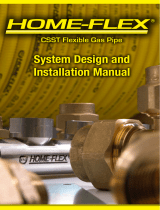
1
Chapter 1: Introduction
1.1 Introduction
HOME-FLEX® CSST and HOME-FLEX Underground® are two dierent systems with dierent
uses and installation requirements. The tubing and ttings are not interchangeable.
An installer must be aware of all of the HOME-FLEX Underground installation instructions and
knowledgeable in all applicable plumbing and building codes. HOME-FLEX Underground
installation practices and guidelines are found in this manual, packaged with each
HOME-FLEX Underground tting and on the HOME-FLEX Underground website,
homeexunderground.com.
HOME-FLEX Underground gas pipe is Medium Density Polyethylene (MDPE) gas pipe. It is
also referred to as PE or poly gas pipe. It is made in accordance with the ASTM D2513 stan-
dard. It is approved for direct burial into the ground in accordance with the local plumbing
code at the installation location. It is exible, lightweight, easy to work with and easy to
install. Unlike metallic gas pipe, it will not rust or corrode when properly installed. HOME-
FLEX Underground PE gas pipe is iron pipe size (IPS). It is approved for use with Natural Gas
or LP gas. It is never to be installed in a building or house. It is never to be installed under a
building or house. It is never to be installed above grade.
HOME-FLEX Underground ttings are approved for direct burial. They can be installed without
the need for special tools or equipment. HOME-FLEX Underground ttings are constructed
of plastic and they are a compression type tting. Once installed, they can be removed and
reinstalled as long as they have not been damaged in any way.
HOME-FLEX Underground couplers, elbows and tees are approved to the ASTM F1924 stan-
dard. They may be used with any brand of properly sized ASTM D2513 Yellow Poly Gas Pipe.
These ttings are sized for IPS Poly Gas Pipe in ½” (SDR 9.3), ¾” (SDR 11), 1” (SDR 11), 1¼” (SDR
11), 1½” (SDR 11) and 2” (SDR 11) diameters. They are approved for use with Natural Gas or
LP Gas. You must verify that your local jurisdiction allows the use of F1924 ttings prior to
performing your installation. The Transition Fittings and Risers are approved to ASTM F1973.
HOME-FLEX Underground gas pipe is approved ASTM D2513.
The HOME-FLEX Underground® Gas Distribution System must be installed by a trained
installer who meets the following criteria:
1. Installer must meet all qualications required by the state and/or local administrative
authority administering the provisions of the code where the gas piping is installed.
2. An installer must also be informed in the use of HOME-FLEX Underground®
Gas Distribution System. Information regarding Valencia Pipe Company’s
HOME-FLEX Underground® system can be obtained by reading the
HOME-FLEX Underground® Gas Distribution System Installation/Training Guide and
registering with Valencia Pipe Company. To obtain a Registered Installer Card, register
online at homeexunderground.com. In submitting either the printed or online regis-
tration, you are arming that you understand all aspects of the installation require-
ments and local plumbing, mechanical, electrical, and/ or applicable building codes.
If you do not understand all requirements and local codes, contact a licensed profes-
sional plumber.
The installation shall be made in accordance with local codes, or, in the absence of local
codes, in accordance with the National Fuel Gas Code (ANSI Z223.1 / NFPA 54); the Liqueed
Petroleum Gas Code (NFPA 58); Natural Gas and Propane Installation Code (CSA B149.1); the
International Fuel Gas Code (IFGC), or the Uniform Plumbing Code (UPC). In addition, ASTM
D2774 (Standard Practice for Underground Installation of Thermoplastic Pressure Piping) and
the installation instructions as prescribed by Valencia Pipe Company must be followed.


























